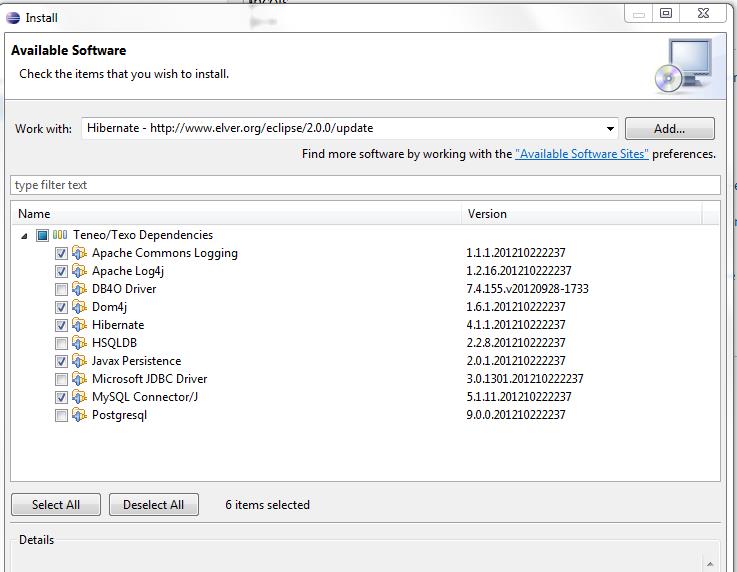Notice: This Wiki is now read only and edits are no longer possible. Please see: https://gitlab.eclipse.org/eclipsefdn/helpdesk/-/wikis/Wiki-shutdown-plan for the plan.
Teneo/Hibernate/Download and Install
Contents
The installation method for Teneo depends on the target environment(Eclipse/OSGI or web container). Both cases are discussed on this page. This page also describes where to find the example projects used in the tutorials in the wiki.
Dependencies
To run Teneo you need the following software:
- EMF
- Hibernate
- JDBC driver
Some dependencies can not be downloaded from eclipse.org because of licensing differences. Teneo provide update sites with the required dependencies (see below for the correct update site depending on your version).
Usage in Eclipse/OSGI: download and install using the update manager
Plugins and dependencies, update site locations
Teneo is delivered in the following versions:
- 2.1.0: EMF 2.10/Eclipse 4.4/Hibernate 4.3.*/JPA 2.0:
- Teneo: http://download.eclipse.org/modeling/emf/teneo/updates/2.1.0/interim/
- EMF: http://download.eclipse.org/releases/luna
- Hibernate and other dependencies: https://www.springsite.com/eclipse/2.1.0/update
- 2.0.0: EMF 2.7-2.8-2.9/Eclipse 3.7-3.8-4.2-4.3/Hibernate 4.1/JPA 2.0:
- Teneo: http://download.eclipse.org/modeling/emf/teneo/updates/2.0.0/interim/
- EMF: http://download.eclipse.org/releases/kepler
- Hibernate and other dependencies: https://www.springsite.com/eclipse/2.0.0/update/
The following update sites are no longer available:
Note: update site urls in the screenshots below maybe outdated, use the update site urls listed above.
The EMF update site, select the EMF/XSD SDK:
The Teneo update site will look similar to this image. Select the Teneo Hibernate SDK:
The springsite (former elver) update site lists the Hibernate, dom4j and a number of JDBC plugins. Select the followings, plus some connectors, depending on your needs :
Creating your own Hibernate plugin
If you want to make your own Hibernate/library plugin there is one specific setting which needs to be set in your plugin: make sure to add the following line to the MANIFEST.MF of the Hibernate/libraries plugin you create:
Eclipse-BuddyPolicy: dependent
This is required otherwise the Hibernate libraries can not find your model classes when performing runtime class enhancement. See here for more information. Note that also other Eclipse-BuddyPolicy settings can be used (and can make sense in production environments) but the 'dependent' setting is the safest one.
Teneo, import-packages and ClassNotFoundException when running junit testcases
The Teneo and Hibernate plugins declare dependencies using import-packages. When running junit testcases as normal Java applications or standard junit tests then there is no OSGI environment which takes care of resolving these import-packages. This means that the import-package dependencies are not resolved and ClassNotFoundExceptions are thrown.
This can be solved by explicitly declaring the dependency in the MANIFEST.MF of your test or model project. As an example: these are the dependendencies set in the examples project:
Require-Bundle: org.eclipse.core.runtime, org.eclipse.emf.ecore;visibility:=reexport, org.eclipse.emf.ecore.xmi;visibility:=reexport, org.eclipse.emf.teneo.hibernate;bundle-version="1.1.2", org.hibernate;bundle-version="3.3.2", org.eclipse.emf.ecore.change, org.apache.commons.logging, org.dom4j, org.hsqldb, com.mysql.jdbc
Usage in a Web Container - Maven
For usage within a web container the following jar files are required. You can download these files from the plugins section on the update site using your web browser, or you can use Maven (see below):
Jars and Dependencies
- Teneo jar files:
- org.eclipse.emf.teneo
- org.eclipse.emf.teneo.annotations
- org.eclipse.emf.teneo.hibernate
- org.eclipse.emf.teneo.hibernate.mapper
- EMF jar files:
- org.eclipse.emf.ecore
- org.eclipse.emf.common
- org.eclipse.emf.ecore.xmi
- Dependencies: Teneo depends on the hibernate and commons-logging jars (and a jdbc jar). You can find them in maven central or you can download directly from their respective websites.
Maven
Teneo and related EMF jar files are published in central maven and in the sonatype-snapshot repository. All of them are published in the org.eclipse.emf group.
The Teneo pom files do not define explicit dependencies. This means that your pom files should list the EMF, commons-logging and hibernate jar file as dependencies.
Download Example Project for Tutorials
The example project (org.eclipse.emf.teneo.hibernate.examples) can be found in git here. To clone the Teneo git repository execute this action:
git clone git://git.eclipse.org/gitroot/teneo/org.eclipse.emf.teneo.git
See this page on how to work with Eclipse GIT repositories.
The main examples project used in the tutorials is the: org.eclipse.emf.teneo.hibernate.examples project.
This example project uses an extended version of the well-known EMF library example. The example project contains the generated model code and a number of tutorial classes showing how to work with EMF, Teneo and Hibernate.
Some more details regarding the example project. The example project consists of the following:
- an ecore model and genmodel (in the model subfolder)
- generated model code (no manual changes done, so you can change the ecore model and regenerate the code)
- a number of tutorial java classes in the org.eclipse.emf.teneo.hibernate.examples package
The MANIFEST.MF of the examples project lists dependencies on several plugins, see the next section for more information on this.



